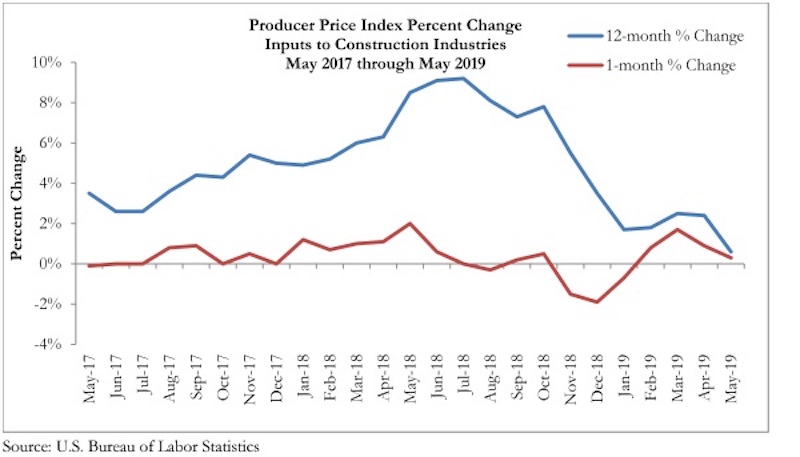Construction input prices rose slightly by 0.3% in May on a monthly basis and are up 0.6% over the last 12 months, according to an Associated Builders and Contractors analysis of U.S. Bureau of Labor Statistics data released today. Nonresidential input prices were also up 0.3% compared to the previous month and are 1.1% higher than they were a year ago.
Among the 11 subcategories, six saw prices fall last month, with the largest decreases in natural gas (-15.2%), unprocessed energy materials (-8.2%) and crude petroleum (-6.2%). Of the remaining five subcategories, only two experienced price increases greater than 1%: nonferrous wire and cable (+1.2%) and prepared asphalt, tar roofing and siding products (+1.1%), which also had the largest year-over-year price increase at 6.3%.
“Based on a variety of factors, materials prices should be escalating in the United States, yet nonresidential construction materials prices remain relatively stable,” said ABC Chief Economist Anirban Basu. “First, demand for materials remains high in the context of ongoing growth in nonresidential construction spending. This is especially true for a number of construction material intensive segments like highway and street. Indeed, prepared asphalt is the only category of construction materials that this report monitors that experienced a price increase exceeding 6% over the past year.
“Second, there is the issue of tariffs, including those that have impacted steel and aluminum prices in recent months,” said Basu. “Despite those surcharges on imported goods, no related categories are associated with significant inflationary pressure, though the price of fabricated steel products is up by a somewhat-above-average 2.8% over the past year. Third, there have been active attempts by certain groups of suppliers, including OPEC members, to truncate supply in an effort to raise prices. In large measure, those efforts have failed, with a host of commodity prices, including oil prices, declining recently.
“There are many factors that have helped to limit materials price increases, including a weakening global economy and the emergence of goods-producing nations like Vietnam and Indonesia,” said Basu. "A strong U.S. dollar has also helped to limit the commodity price increases encountered by America’s construction firms.
“For contractors, this comes as good news,” said Basu. “While U.S. construction firms will continue to wrestle with rising compensation costs, materials prices are likely to remain well behaved over the near term. There is little evidence that the global economy is reaccelerating. Moreover, the Trump administration recently removed tariffs on steel and aluminum with respect to Canada and Mexico. Finally, while public construction spending growth has been robust of late, there is some evidence that spending growth has become less intense in a number of private construction segments, which would have the effect of limiting demand for certain materials, all things being equal.”
Related Stories
Market Data | Jan 6, 2016
Census Bureau revises 10 years’ worth of construction spending figures
The largest revisions came in the last two years and were largely upward.
Market Data | Jan 5, 2016
Majority of AEC firms saw growth in 2015, remain optimistic for 2016: BD+C survey
By all indications, 2015 was another solid year for U.S. architecture, engineering, and construction firms.
Market Data | Jan 5, 2016
Nonresidential construction spending falters in November
Only 4 of 16 subsectors showed gains
Market Data | Dec 15, 2015
AIA: Architecture Billings Index hits another bump
Business conditions show continued strength in South and West regions.
Market Data | Dec 7, 2015
2016 forecast: Continued growth expected for the construction industry
ABC forecasts growth in nonresidential construction spending of 7.4% in 2016 along with growth in employment and backlog.














